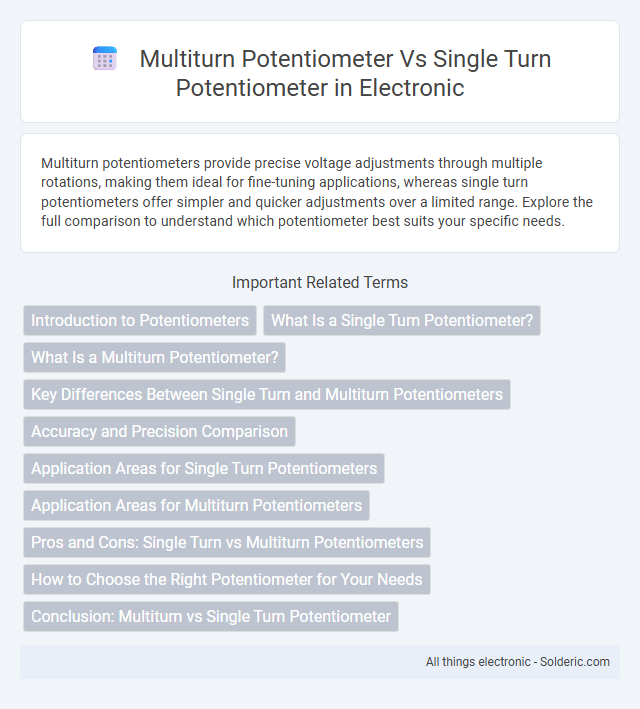Multiturn potentiometers provide precise voltage adjustments through multiple rotations, making them ideal for fine-tuning applications, whereas single turn potentiometers offer simpler and quicker adjustments over a limited range. Explore the full comparison to understand which potentiometer best suits your specific needs.
Comparison Table
| Feature | Multiturn Potentiometer | Single Turn Potentiometer |
|---|---|---|
| Number of Turns | Multiple (commonly 5 to 10 turns) | Single turn (typically 270deg rotation) |
| Precision | High precision, fine adjustment | Lower precision, coarse adjustment |
| Resolution | Superior resolution due to multi-turn mechanism | Lower resolution, limited by single rotation |
| Applications | Calibration, tuning, and measurement requiring fine control | Volume control, user interface adjustments |
| Size | Typically larger due to multi-turn design | Compact size |
| Cost | Higher cost due to complexity | Lower cost |
| Durability | Longer lifespan, designed for frequent adjustments | Standard durability |
Introduction to Potentiometers
Multiturn potentiometers offer precise resistance adjustments through multiple rotations, allowing finer control compared to single turn potentiometers, which complete their adjustment within a single 270-degree turn. Single turn potentiometers are typically used for simpler, less precise applications, while multiturn versions provide enhanced accuracy in calibration and fine-tuning of electronic circuits. The choice between multiturn and single turn potentiometers depends on the required resolution and stability in applications such as instrumentation, audio equipment, and control systems.
What Is a Single Turn Potentiometer?
A single turn potentiometer is an adjustable resistor designed to vary resistance within one complete rotation of its knob or shaft, typically ranging from 270 to 300 degrees. It provides precise control over voltage and current in circuits with limited adjustment needs, often used for tuning and calibration in electronic devices. Your choice between multiturn and single turn potentiometers depends on the required resolution, with single turn models offering quicker adjustments but less fine control.
What Is a Multiturn Potentiometer?
A multiturn potentiometer is an adjustable resistor that requires multiple turns of the knob or screw to change its resistance value, allowing for precise control over voltage and current in electronic circuits. Unlike single-turn potentiometers, which complete their adjustment within one rotation, multiturn types offer finer resolution and more accurate settings, ideal for calibration and tuning applications. Your projects benefit from multiturn potentiometers when precise resistance adjustment and stability are critical.
Key Differences Between Single Turn and Multiturn Potentiometers
Single turn potentiometers rotate up to 270 degrees to adjust resistance, suitable for quick, coarse adjustments, while multiturn potentiometers offer multiple rotations, often 5 to 10 turns, enabling high precision and fine tuning. Single turn types are commonly used in volume controls or simple calibration tasks, whereas multiturn versions excel in applications requiring exact voltage or position settings, like instrumentation and industrial controls. The key differences include rotational range, adjustment precision, and typical use cases, with multiturn potentiometers providing greater resolution and stability.
Accuracy and Precision Comparison
Multiturn potentiometers provide higher accuracy and precision than single turn potentiometers due to their ability to make fine adjustments through multiple rotations, often ranging from 5 to 20 turns per full resistance range. Single turn potentiometers typically support only a 270-degree rotation, limiting resolution and making them less suitable for applications requiring precise control or calibration. The increased mechanical resolution in multiturn potentiometers results in finer resistance increments, enhancing repeatability and stability in sensitive electronic circuits.
Application Areas for Single Turn Potentiometers
Single turn potentiometers are widely used in consumer electronics, audio equipment, and instrumentation for precise volume control and signal adjustment within a limited range. Their compact size and simpler design make them ideal for applications requiring quick, repetitive adjustments without extensive rotation. These potentiometers excel in situations where cost-effectiveness and durability are critical, such as in radio tuners, light dimmers, and adjustable power supplies.
Application Areas for Multiturn Potentiometers
Multiturn potentiometers are widely used in precision applications such as industrial equipment calibration, instrumentation, and control systems where fine adjustment and high resolution are critical. These potentiometers enable accurate setting of resistance values over multiple turns, making them ideal for applications requiring exact voltage or current control in aerospace, medical devices, and robotics. Their reliability and durability in harsh environments also make them suitable for heavy machinery and automation processes.
Pros and Cons: Single Turn vs Multiturn Potentiometers
Single turn potentiometers offer simplicity and faster adjustment, making them suitable for applications requiring quick tuning with limited precision. Multiturn potentiometers provide higher resolution and finer control, ideal for settings demanding accurate positioning and repeatability, but they are typically bulkier and more expensive. Choosing between them depends on your need for speed versus precision in adjusting electrical parameters.
How to Choose the Right Potentiometer for Your Needs
Selecting the right potentiometer depends on the required precision and range of adjustment in your application. Multiturn potentiometers offer finer control with multiple rotations, ideal for calibration tasks needing high accuracy, while single turn potentiometers provide simpler, quicker adjustments for general purposes. Consider your need for resolution, mechanical durability, and space constraints to choose the potentiometer that best fits your project's specifications.
Conclusion: Multiturn vs Single Turn Potentiometer
Multiturn potentiometers offer greater precision and finer control over resistance adjustments compared to single turn potentiometers, making them ideal for applications requiring accurate tuning and repeatability. Single turn potentiometers are simpler, more cost-effective, and suitable for basic volume or speed control where exact calibration is less critical. Your choice depends on the required resolution and stability, with multiturn potentiometers favored for precision instruments and single turn options for general-purpose uses.
Multiturn potentiometer vs single turn potentiometer Infographic

 solderic.com
solderic.com